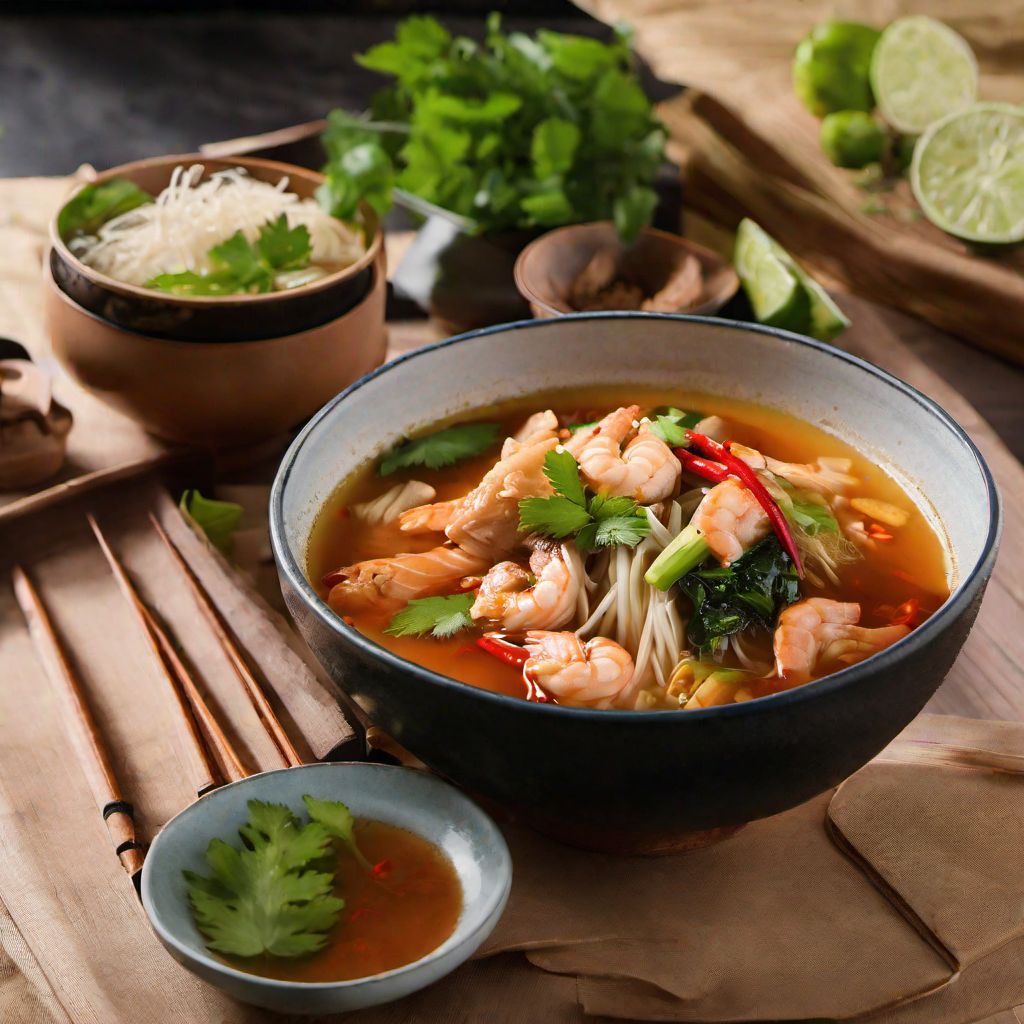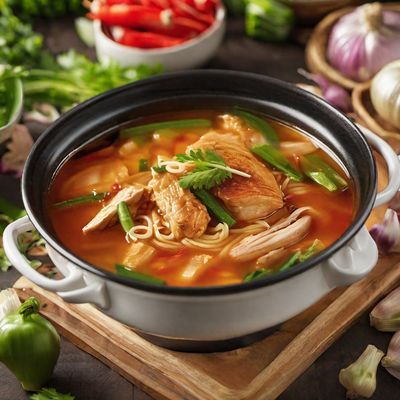
Recipe
Thai-style Budae Jjigae
Spicy Thai Army Stew: A Fusion of Flavors
4.8 out of 5
In Thai cuisine, bold flavors and aromatic spices take center stage. This Thai-style Budae Jjigae is a delightful fusion of Korean and Thai cuisines, combining the comforting elements of the original dish with the vibrant and spicy Thai twist. Get ready to indulge in a hearty and flavorful stew that will transport your taste buds to the streets of Bangkok.
Metadata
Preparation time
20 minutes
Cooking time
15 minutes
Total time
35 minutes
Yields
4 servings
Preparation difficulty
Medium
Suitable for
Pescatarian, Dairy-free, Gluten-free (if using gluten-free soy sauce), Nut-free, Low-carb (if omitting rice noodles)
Allergens
Shellfish (shrimp), Soy (soy sauce)
Not suitable for
Vegan, Vegetarian, Paleo, Keto, High-protein
Ingredients
While the original Korean Budae Jjigae is known for its combination of Korean ingredients like kimchi, spam, and instant noodles, this Thai adaptation infuses the stew with Thai flavors. The addition of Thai herbs, spices, and condiments such as lemongrass, Thai chili paste, and fish sauce gives this dish a unique and fiery Thai twist. We alse have the original recipe for Budae jjigae, so you can check it out.
-
2 cups (470ml) chicken broth 2 cups (470ml) chicken broth
-
1 lemongrass stalk, bruised 1 lemongrass stalk, bruised
-
2 kaffir lime leaves 2 kaffir lime leaves
-
2 tablespoons Thai chili paste 2 tablespoons Thai chili paste
-
1 tablespoon fish sauce 1 tablespoon fish sauce
-
1 tablespoon soy sauce 1 tablespoon soy sauce
-
1 tablespoon palm sugar 1 tablespoon palm sugar
-
200g chicken breast, thinly sliced 200g chicken breast, thinly sliced
-
150g shrimp, peeled and deveined 150g shrimp, peeled and deveined
-
100g firm tofu, cubed 100g firm tofu, cubed
-
100g enoki mushrooms 100g enoki mushrooms
-
100g canned sliced sausages 100g canned sliced sausages
-
100g instant rice noodles 100g instant rice noodles
-
1 cup (240ml) coconut milk 1 cup (240ml) coconut milk
-
1 cup (240ml) water 1 cup (240ml) water
-
1/4 cup (15g) chopped cilantro 1/4 cup (15g) chopped cilantro
-
2 green onions, sliced 2 green onions, sliced
-
Lime wedges, for serving Lime wedges, for serving
Nutrition
- Calories (kcal / KJ): 380 kcal / 1590 KJ
- Fat (total, saturated): 18g, 10g
- Carbohydrates (total, sugars): 25g, 5g
- Protein: 30g
- Fiber: 3g
- Salt: 2.5g
Preparation
-
1.In a large pot, bring the chicken broth to a simmer over medium heat.
-
2.Add the lemongrass stalk and kaffir lime leaves to the pot and let them infuse the broth for 5 minutes.
-
3.Stir in the Thai chili paste, fish sauce, soy sauce, and palm sugar until well combined.
-
4.Add the chicken breast, shrimp, tofu, enoki mushrooms, and sliced sausages to the pot. Cook for 5 minutes or until the chicken is cooked through and the shrimp turns pink.
-
5.Meanwhile, cook the instant rice noodles according to the package instructions. Drain and set aside.
-
6.Pour in the coconut milk and water into the pot. Bring the stew to a gentle boil.
-
7.Add the cooked rice noodles to the pot and simmer for an additional 2 minutes.
-
8.Remove the lemongrass stalk and kaffir lime leaves from the stew.
-
9.Garnish with chopped cilantro and sliced green onions.
-
10.Serve the Thai-style Budae Jjigae hot with lime wedges on the side.
Treat your ingredients with care...
- Lemongrass — Bruise the lemongrass stalk by lightly pounding it with the back of a knife to release its flavor.
- Thai chili paste — Adjust the amount of chili paste according to your spice preference. Add more for extra heat or reduce for a milder version.
- Coconut milk — Shake the can of coconut milk before opening to ensure the cream and liquid are well combined.
Tips & Tricks
- For a vegetarian version, omit the chicken and shrimp and add more tofu and vegetables like bell peppers and bok choy.
- Customize the spiciness by adjusting the amount of Thai chili paste or adding fresh Thai chilies.
- Feel free to add other Thai herbs like Thai basil or cilantro stems for extra flavor.
- If you prefer a thicker stew, simmer it for a longer time to reduce the liquid.
- Leftovers can be stored in the refrigerator for up to 3 days. The flavors will continue to develop, making it even more delicious the next day.
Serving advice
Serve the Thai-style Budae Jjigae in individual bowls, allowing everyone to customize their own toppings and spice level. Squeeze fresh lime juice over the stew before enjoying to add a tangy kick. Serve with steamed jasmine rice or crusty bread on the side to soak up the flavorful broth.
Presentation advice
Garnish the Thai-style Budae Jjigae with a sprinkle of chopped cilantro and sliced green onions on top. The vibrant green colors will add freshness and visual appeal to the stew. Serve it in colorful ceramic bowls to enhance the presentation and make it even more inviting.
More recipes...
For Budae jjigae » Browse all
For Korean cuisine » Browse all
More Korean cuisine dishes » Browse all

Dwaeji gukbap
Pork soup with rice
Dwaeji gukbap is a traditional Korean soup that is made with pork and rice. It is known for its hearty flavor and warming properties, and is often...

Gejang
Gejang is a traditional Korean dish that is made with raw crab marinated in soy sauce and other seasonings. It is typically served as an appetizer.

Nadugi
Nadugi is a Korean dish that is made with tofu, vegetables, and a spicy sauce. It is a healthy and flavorful dish that is perfect for vegetarians.
More Thai cuisine dishes » Browse all

Khai phalo
Thai Egg Stew
Khai phalo is a traditional Thai curry made with eggs and vegetables. It is a simple and flavorful dish that is perfect for a quick and easy meal.

Nam pla wan
Sweet and sour fish sauce
Nam pla wan is a Thai dish made with fish sauce, palm sugar, and lime juice. It is a sweet and sour sauce that is typically served with fresh...

Khao op sapparot
Pineapple Fried Rice
Khao op sapparot is a Thai dish made with rice and pineapple. It is a sweet and savory dish that is popular in Thailand and other Southeast Asian...










